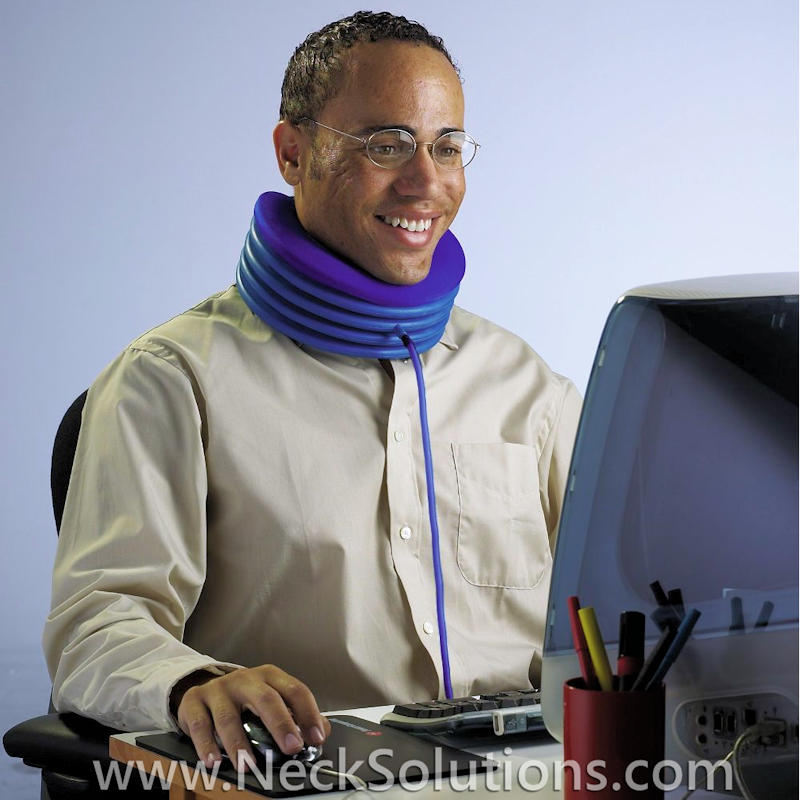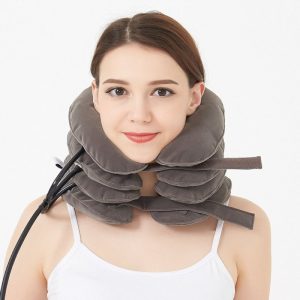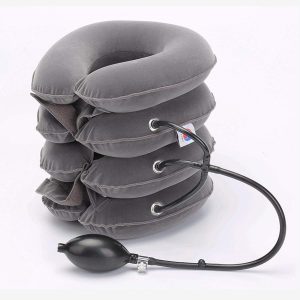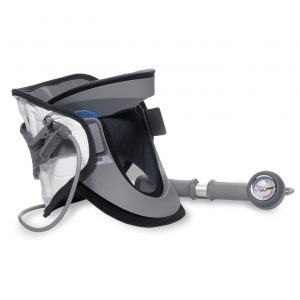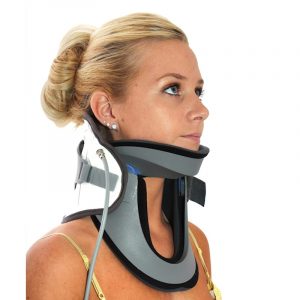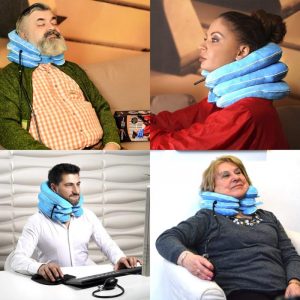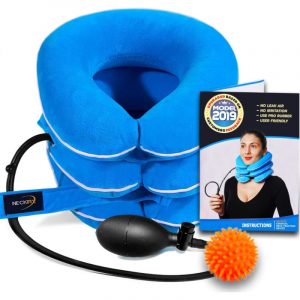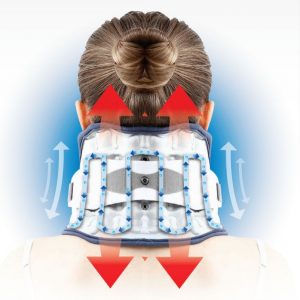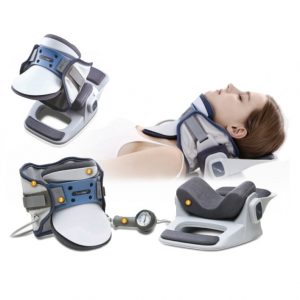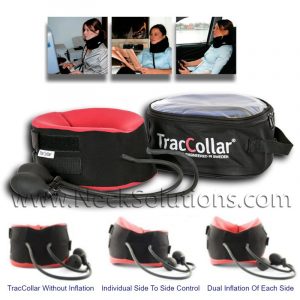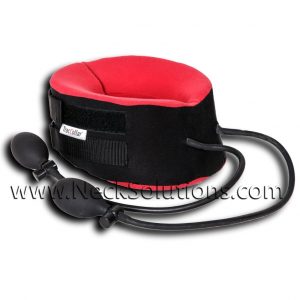Neck Traction Collars – What You Need To Know
The neck or cervical spine is vulnerable to conditions that cause pain and reduce motion. Neck pain often results from poor posture habits when working or sleeping in an awkward position, muscle strain injuries, joint irritation, stress & tension, headaches, arthritis or bulging, herniated discs. Can neck traction collars help?
Neck traction collars may help you to improve your posture and provide neck pain relief by gently lifting the weight of your head off of your neck and shoulders providing decompression in the cervical spine for recommended relief of neck pain.
Benefits:
For those whom experience arthritis with pain in the neck and shoulders, neck traction collars can help to take pressure of gravity off the stiff and painful joints in comfort and help to improve mobility of cervical spine. They are air powered traction collars which helps relieve downward pressure on cervical spine discs, thereby removing compressive forces which helps to reduce herniations, disc protrusions, bulges and ease the pain of pinched nerves and associated symptoms, which can cause the pain to radiate into the shoulder, arm and hand. By decreasing pressure, it also improves the blood flow to the neck, shoulders and arms, which can lead to reduced tension and promote healing, as well as relax muscles.
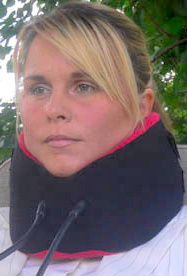 They are operated by 1 or 2 hand held inflation devices that inflates the collar on one or both sides to create an upward pressure on the head, providing traction and relieving pressure from compressed discs, pinched nerves, irritated joints and stiff muscles – a major causes of neck pain.
They are operated by 1 or 2 hand held inflation devices that inflates the collar on one or both sides to create an upward pressure on the head, providing traction and relieving pressure from compressed discs, pinched nerves, irritated joints and stiff muscles – a major causes of neck pain.
You are under complete control of neck traction, customizing the level of force through inflation and are able to precisely control the amount of traction for the entire cervical spine or both the right and left side of the neck. Dual sided may provide an advantage over other types of inflatable traction devices and allowing more or less traction to be applied to a specific side, which can be beneficial with different types of disc herniations, arthritic formations as well as accommodating scoliosis conditions.
Forget electrical cords, no heavy and messy water bags that are tied to a door with pulleys, or uncomfortable halters commonly seen with many home neck traction products. Traction collars are easy to use, comfortable, safe and effective. Recommended by medical doctors, physical therapists & chiropractors as an effective home treatment or for continued in office therapy in the comfort of your own home, office or when traveling.
Neck Traction Collar Uses
They can be used when watching TV, using a computer at home or work, standing, sitting and lying down (with a pillow under the head or specific designed holder). Because it is compact and lightweight, it is great for use when traveling, so you do not have to go without neck pain relief on the road.
Can Traction Collars Help Me?
Traction is a recognized method of treatment used by Physical Therapists and Chiropractors to pull the neck slightly, providing traction for neck pain relief. Always consult your health care provider before use.
May help with:
- Tension and stiffness in neck and shoulders
- Sore neck and shoulders
- Headaches from neck tension & stress
- Stiff neck muscles
- Disc problems
- Numbness, tingling, weakness, cold sensation in the arms and/or hands
- Pinched nerves in the neck causing radiating pain
- Poor posture from work, aging, injuries and bad habits
- Stress causing neck and shoulder tension
- Carpal Tunnel Syndrome
- Repetitive injuries in the upper arm
- Bursitis, tendinitis and osteoarthritis in the neck
Neck Pain Relief & Rehab Of The Cervical Spine
If you have a neck injury, you may have a herniated or bulging disc and are in pain, perhaps with symptoms of a pinched nerve and have pain or tingling in the hand, arm or shoulder, facet joint arthritis, headaches, or postural pain from poor ergonomics. You may find using this type of collar affords welcomed relief.
With traditional over the door traction, if the water is to heavy, you must get out of the unit, take it down, pour out the water and this becomes very cumbersome. In addition to the traditional form of traction being very restrictive, you are less likely to follow through with treatment.
You can also apply traction and then do active rehabilitative exercises and get a combination of isometric and isotonic exercise, actively engaging the neck muscles against resistance. You can bend your head to the right 3 times and then to the left 3 times. This can be done with other ranges of motion to strengthen the neck muscles while the traction is in place and the pain reduced, allowing earlier rehabilitation and recovery.
Traction Collars provide the health care professional with an effective means of continuing beneficial office treatment at home and offers an effective means to obtain neck pain relief, assisting the patient in reducing or minimizing the necessity for medications.
What are the Effects of Traction Collars?
Traction has several effects. Among these are distraction or separation of the vertebral bodies, a combination of distraction and gliding of the facet joints, tensing of the ligamentous structures of the spinal segment, widening of the intervertebral foramen, straightening of spinal curves, and stretching of the spinal musculature. There is evidence that a disc protrusion can be reduced and spinal nerve root compression symptoms relieved with the application of traction.
Epidurography studies demonstrate temporary reductions of the disc protrusions, along with clinical improvement. Disc reduction is theorized due to a suction effect caused by decreased intradiscal pressure. The change in intradiscal pressure caused by traction also has been theorized to positively affect the disc’s nutrition.
A 2014 study in the journal Spine studied the influence of traction treatment on the disc annulus microstructure, along with molecular transportation, and cell viability of degraded discs. They found traction treatment is effective in enhancing nutrition supply and promoting disc cell proliferation of degraded discs.
A 1992 study in Spine the front and back of the disc spaces were increased by traction at neutral position and in 30 degrees flexion (head down). The separation of facet joint surfaces was found after traction at 15 degrees extension (head back), but not in the neutral or flexion positions. So, pain from a facet joint syndrome is better in extension, while head straight or bent down is better for the disc. While both conditions may be involved with disc degeneration, experimenting with head position can find the best relief and benefit.
What are the Indications?
The significant indications are (a) herniated disc or radiculopathy, (b) any condition in which mobilization and stretching of soft tissue are desired, and (c) any condition in which opening the neural foramen is desired.
What are the Contraindications?
Traction is contraindicated in patients with structural disease secondary to tumor or infection, rheumatoid arthritis, severe vascular compromise, and any condition for which movement is contraindicated. Relative contraindications include acute strains and sprains and inflammatory conditions that may be aggravated by traction. Strong traction applied to patients with spinal joint instability may cause further strain. Traction should be avoided if the patient has had recent spinal fusion.
Because spinal fusion techniques and healing rates vary from patient to patient, the surgeon should be consulted before applying traction if the fusion is less than 1 year old. Other relative contraindications may include pregnancy, osteoporosis, hiatal hernia, and claustrophobia.
Which Traction Mode Is Best – Static or Intermittent?
The traction mode will depend on the disorder being treated and the comfort of the patient. A herniated disc is usually treated more effectively in static mode or with longer hold-rest periods (3 to 5 minute hold, 1 minute rest) in intermittent mode. Joint dysfunction and degenerative disc disease usually responds to shorter hold-rest periods (1 to 2 minute hold, 30 second rest) in intermittent mode. This gives a guideline for hold and rest variables. For rest period, the release valves are pressed to let out the amount of air to reduce traction.
What is the Treatment Time With Neck Traction Collars
When treating herniated discs, the treatment time should be relatively short. As the disc space widens, the intradiscal pressure decreases, causing the herniated disc material to be retracted into the disc space. The decrease in pressure is temporary, however, because eventually the decreased intradiscal pressure will cause fluid to be imbibed into the disc. When pressure equalization occurs, the suction effect on the disc protrusion is lost, and it is possible for patients to experience a sudden increase in pain when traction is released. If the traction time is 8 to 10 minutes, this effect is minimized.
For other conditions, a treatment time of up to 20 minutes is often used. As a general rule, the higher the traction force, the shorter the treatment time. Often the first treatment is only 3 to 5 minutes long. This gives a chance to determine the patient’s reaction to the traccollar and plan treatment progression accordingly.
